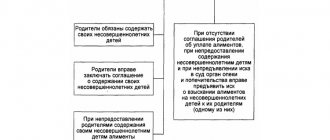Appointment of alimony in a fixed amount of money
Content
Alimony in a fixed amount should be understood as payments for children and other persons in a fixed amount. They are assigned as a multiple of the subsistence minimum in the recipient’s region of residence and are subject to indexation according to the increase in the size of the subsistence minimum. If there is no established minimum, the all-Russian indicator is used.
The main purpose of alimony is financial support for people in need:
- minor children of payers;
- spouses;
- close relatives.
Grounds for assigning alimony
The grounds are described in Art. 83 RF IC. Collection of alimony in a fixed amount is made for all disabled relatives of the payer, including adult children.
The opportunity to collect cash payments as a percentage of income is available exclusively to minor children of the alimony provider.
All other potential recipients can only claim a fixed amount in court:
- spouse and ex-spouse;
- disabled adult child;
- parents;
- stepmother and stepfather;
- educators;
- Grandmothers and grandfathers.
But for minor children, the option of alimony in the form of a percentage is a priority. A fixed amount is assigned only if the payer:
- does not have a regular income;
- receives a salary in foreign currency;
- hides the exact salary amount.
When determining the amount of payments, the court is guided by the maximum preservation of the child’s standard of living, the financial situation of the parties and the cost of living. The difference between shared alimony and a fixed amount is that the first method directly depends on the salary, and the second is assigned regardless of the payer’s income level.
Even if he does not have a job and does not receive state benefits, it is possible to assign payments for a child that are a multiple of the minimum for living in the region.
There is no such opportunity to collect maintenance from other relatives. Other plaintiffs must prove that the defendant has the financial ability to provide for them.
There is a third option - the assignment of mixed alimony, when the alimony obligee pays both a percentage of the salary and a fixed amount from additional income: renting out an apartment, entrepreneurial activity, etc.
Concept and purpose
Alimony in a fixed amount is payments from the alimony payer to the recipient, established on the basis of a judicial act. They are determined in a monetary amount, and not as a percentage of the payer’s earnings.
Alimony in a fixed amount is established when this seems to be a more profitable option than payments as a percentage of income. This may be when the payer has no official income at all, as well as when his official income is insignificant.
The choice of calculation method lies with the applicant. He indicates the amount in the claim and provides the court with evidence that the recipient requires alimony to be established in this particular amount, and not in a smaller amount. The court takes into account all arguments, including those of the defendant, who may try to reduce the amount (for example, by pointing out his state of health and the need for treatment or the presence of other dependents).
Alimony in a fixed amount can be established when the payer actually hides his real income. He negotiates with the employer and receives a “gray” salary. It is quite difficult to prove this fact and court decisions on this issue are ambiguous. But recipients are still recommended to file petitions with the courts to establish a fixed amount of payments.
The applicant may try to prove that the payer's income is unstable. This situation will comply with the rules of law and will help establish a new calculation procedure.
How much should a parent of a child with disabilities expect? The answer is presented in the article “How is child support paid for a disabled child.” You can read about the right to exemption from paying alimony here.
The procedure for collecting alimony in a fixed amount of money
The procedure for collecting alimony in a fixed amount looks like this:
- Preparation. The plaintiff (parent, spouse, adult child) receives evidence of the defendant’s financial capabilities. The parent of a minor child is exempt from this need (the funds will be collected even if the defendant does not work). It is important to comply with other grounds for recovery specified in Art. 83 RF IC.
- Paperwork. A claim is drawn up and a package of documents is collected.
- Going to court. The claim is filed at the place of residence of the defendant or the registered address of the plaintiff.
- Preparing for the process. The parties receive court notices. The judge makes a decision to initiate legal proceedings within 5 days from the date of registration of documents.
- Trial. On the appointed day, the plaintiff and defendant appear at the court hearing. The court examines the circumstances of the case and the evidence presented by the parties, then makes a decision.
The result of the proceedings is the execution of a writ of execution - it can be presented to the bailiffs to initiate enforcement proceedings or you can try to collect alimony from the payer yourself, guided by this document.
Jurisdiction
The claim is filed in the magistrate's court at the registered address of the plaintiff or defendant. If the amount of claims exceeds 50,000 rubles, the documents are submitted to the district judicial authority.
When collecting alimony in the form of a fixed amount, the plaintiff cannot apply for a court order. The issue is resolved exclusively through legal proceedings.
Statement of claim (sample)
There is no established form for a claim for the collection of alimony, but if complied with, information must be provided in accordance with the requirements of the Code of Civil Procedure of the Russian Federation:
- Full name, passport details, date of birth, registered address of the plaintiff;
- Full name, place of residence and work of the defendant;
- dates of marriage and divorce, information from marriage certificates;
- Full name, dates of birth of common children;
- claims for the recovery of payments in a fixed amount, indicating the grounds;
- date of registration and signature of the plaintiff.
The application is provided in two copies - one is given to the court secretary, and the second is marked as accepted and returned to the plaintiff.
Required documents
When going to court, in addition to the claim, you are provided with:
- passport;
- copies of marriage, divorce, birth certificates;
- receipts confirming expenses for the child;
- evidence of the defendant's income;
- certificate of your own salary.
State duty amount
Plaintiffs in cases of alimony collection are exempt from paying state duty; it is subsequently collected from the defendants. You will have to pay 150 rubles if payments are assigned to a child, and 300 rubles. – when claiming alimony for a spouse.
Learn more about the amount and procedure for paying state fees for alimony.
Application processing time
In accordance with Part 2 of Art. 154 of the Code of Civil Procedure of the Russian Federation, cases of collection of alimony are considered for no more than 1 month. The failure of the defendant to appear is not grounds for extending the deadline, but the meeting may be postponed if he warns about this in advance and provides evidence of valid reasons for the absence.
Learn more about the procedure and time frame for considering a claim for alimony in court.
Arbitrage practice
As judicial practice shows, requests for alimony in a fixed amount are most often made in the absence of official earnings from the payer. If the former spouse does not have a job, this is not a basis for exemption from alimony obligations; payments are assigned in any case.
If the payer receives unemployment benefits and the plaintiff requests a fixed amount, the claim will be denied - in this case, payments will be made in shares.
Example from judicial practice:
The monthly minimum wage in the region is 9,500 rubles. The woman left with two minor children. The official earnings of a man are 10,000 rubles; only 3,300 rubles are paid in the form of alimony.
The ex-wife found out that the payer had a solid bank account, and began collecting evidence to change the method of collecting alimony and the correct calculation. For two months, she saved up checks and receipts confirming expenses for children.
After calculation, it was found that 20,000 rubles are spent per month on each child. The woman’s salary is 15,000 rubles, and her relatives help her.
The claims demand the recovery of alimony in the amount of 10,000 rubles. per child, which is slightly above the subsistence level. The plaintiff provided confirmation of the defendant's bank account.
The amounts of alimony are calculated taking into account the division of expenses in half, which does not violate the provisions of Art. 61 IC RF.
Having examined the case materials and examined the evidence, the court satisfied the claims, obliging the defendant to transfer 10,000 rubles. for each minor monthly.
Court order
When the document has already been issued by a judge, the process is simplified. It can be carried out without a court hearing, that is, in absentia. It may be based on papers provided by the plaintiff. This procedure for issuing an order is carried out so that children are not left without support for any period of time.
In the case of a court order, the defendant has a period of ten days to file an objection. The judge will then cancel his order and the case will proceed as usual. But if the deadline was missed for a good reason, then the defendant can file a petition to restore it. However, after ten days and without a valid reason, the right to file a cassation appeal is retained.
Appealing a court decision on alimony
A court decision before it enters into legal force is challenged through an appeal procedure. To do this, it is necessary to file an appeal with the court that accepted the unsatisfactory verdict. Subsequently, the documents are transferred to the appeal board.
The result of the proceedings is the issuance of an appeal ruling to cancel the court decision in whole or in part, or to leave the document unchanged.
If the deadline for appeal is missed and the decision has entered into force, a cassation appeal is filed in the same way.
How to start the process
According to the law, such a complaint can be filed within a month from the date of the court decision. During this period it is considered that it has not yet entered into force. At the same time, there is a decision, and it sets out what the court based it on.
First of all, the judge is sent an application to receive a reasoned decision. Then the period is three days from the date of announcement. But the period for producing the document itself is longer. It lasts five days.
This decision contains the facts, the law the judge used, and the specific circumstances. In the process of challenging, when a complaint is written, it should include all possible grounds for the disputed alimony, which may serve as an aid in reducing the amount or canceling payments altogether. True, finding them is not so easy. Each case is individual. Therefore, before appealing a decision, you need to carefully study all the documents.
Agreement on alimony in a fixed amount (sample)
According to the RF IC, citizens can draw up agreements to pay alimony during marriage or after divorce. It is permissible to draw up an agreement during legal proceedings when the parties come to a mutual agreement.
An alimony agreement is a document by which parents independently determine the amount of alimony and the frequency of payments. It should be taken into account that the amount of monetary support cannot be less than the amount established in court.
To complete the agreement, you must complete several steps:
- Agree when and in what amount alimony will be paid.
- Write down the individual terms of the agreement in a draft.
- Contact a notary to draw up the document, having previously paid the state fee.
- Receive certified agreements - each party is given one copy, the third remains in the archives of the notary.
The agreement has the force of a writ of execution and is used for voluntary payments. It is necessary to contact the bailiffs or the accounting department at the payer’s place of employment only if he stops paying alimony.
What information is contained in the agreement:
- Full name, registration addresses, passport details of the parties;
- information about children and birth certificates;
- amount of alimony payments, frequency of transfer;
- liability for failure to fulfill the terms of the contract;
- date of preparation and signature of the parties.
To change the amount of alimony under the agreement, it is enough to conclude an additional agreement to it. The second document indicates which points need to be adjusted. Unilateral adjustments are not allowed.
If the alimony payer refuses to comply with the demands of the claimant, it is necessary to go to court.
Parents' agreement to reduce payment
There may be cases when parents have disagreements on the issue of reducing the monthly payment.
- If an agreement is concluded between them to provide child support, they have the right to adjust the amount paid. Like the main contract, it must be notarized.
- An agreement can also be reached during the trial. The parties have the right to enter into a settlement agreement determining a reduced payment. It must be approved by a judge. If the terms of the agreement do not put the parties at a disadvantage, the document will be approved and the proceedings will cease.
Changing the amount of alimony payments
The amount of alimony can be changed up or down. To adjust payments, you need to know the grounds on which you can go to court.
Increase in size
Increasing the amount of alimony is possible by drawing up an alimony agreement or in court. The recipient may file a claim if the following grounds exist:
- Significant reduction in salary levels. When assigning alimony, the financial situation of both parties is taken into account.
- Job loss.
- Deterioration of financial situation for good reasons: assignment of alimony obligations, birth of another child, etc.
- Receipt of disability, deterioration of health, and therefore the recipient is unable to work.
- Illness of a child for whom funds are paid. Here it is possible to recover additional amounts on the basis of Art. 86 RF IC. Current and future treatment costs are divided equally between the parents.
- A sharp increase in prices for essential goods, provided that the claimant's earnings remain unchanged.
The payer can also increase alimony voluntarily. If the recipient refuses this, you should go to court, presenting evidence of an increase in income or release from other alimony obligations.
Downsizing
The legislation does not establish grounds for reducing the amount of alimony, but when making a decision, the court may take into account the factors for which alimony-obligated persons apply for a reduction in payments.
You can go to court with a claim to reduce the amount of alimony in a fixed amount to the payer in the following cases:
- The financial situation has worsened for a good reason: the emergence of other alimony obligations, the need for care and treatment of a close relative, a decrease in income, a reduction in work, dismissal.
- Change in the recipient's marital status. If a woman gets married and the new spouse recognizes himself as the father of the children, the payer’s alimony obligations are canceled.
A complete list of grounds for termination of obligations to pay alimony is contained in Art. 120 IC RF. This may be the child reaching adulthood, emancipation, or the death of the recipient or child support obligee.
Important! A significant increase in the recipient’s income level is not a basis for reducing the amount of payments. Even if a woman earns 10 times more than her ex-husband, she will have to pay the money according to the court decision.
When can a claim be filed?
To justify your disagreement with the amount of alimony obligations, you need to set out in detail the essential circumstances in your appeal. These include the following.
- Difficult financial situation of the responding party. If the payer is indeed unable to make payments in full, then at least the amount of alimony will be revised. The question of their complete abolition may also be raised.
- Disability. If a spouse becomes disabled as a result of alcoholism or drug addiction or commits a crime, then alimony can be easily contested.
- Short period of marriage. This point is taken into account if the duration of the marriage is less than 5 years.
- Improper performance of step-parent duties. A grown child will appeal child support if a stepfather or stepmother has filed for it, using this basis.
- The presence of minor children in the new family of the alimony payer.
- A child living with a spouse who behaves unworthy.
This is important to know: How to remove alimony debt from bailiffs
Changing the form of alimony payments
Depending on the situation, the payer or the claimant may apply to the court with a claim to change the form of collection of alimony established in the writ of execution.
From interest to hard money
The claimant has the right to transfer alimony with a share into fixed amounts if the payer loses his job, the currency of receiving the salary changes, or if the monthly salary is unstable.
Procedure:
- The amount of expenses per child is calculated. To do this, you need to collect all receipts for expenses and add up the amounts received.
- A lawsuit is filed. The claims indicate a change in the method of collection with justifications, referring to the provisions of Art. 83 RF IC.
- After receiving the court decision and writ of execution, the ID is submitted to the FSSP.
If alimony was calculated at the place of work and the payer continues to work there, the writ of execution is sent to the accounting department. Starting next month, alimony payments will be received in a fixed amount.
From a fixed amount of money to interest
The transfer procedure is relevant if the person liable for alimony has found a new job or another official source of income from which contributions can be made in accordance with Art. 81 IC RF.
Important! In this case, both the claimant and the payer can file a claim, if there are appropriate grounds.
Establishment by the court of alimony of less than half the subsistence minimum
Taking into account the equal obligation of parents to support minor children, the establishment by the court of alimony to be collected from one of the child’s parents in the amount of less than half the corresponding subsistence minimum for children may occur in cases where the financial and (or) marital status of the alimony payer or other deserving attention, the circumstances objectively do not allow him to collect alimony in the amount of half the corresponding subsistence level for children.
If the cost of living decreases, which is determined by the cost of the consumer basket and can decrease with a decrease in the price level, the established “fixed” amount of alimony is not subject to reduction.
Lawyer's answers to questions about alimony in a fixed amount
Is it possible to collect alimony in a fixed amount if a person works?
To make a claim, the provisions of Art. 83 RF IC. If there is confirmed earnings, payments are assigned in shares. The court's decision is made individually depending on the circumstances of the case and the financial situation of the parties, but the likelihood of a positive result in such a situation is low.
What happens to fixed alimony payments if the cost of living decreases?
Payments in a fixed amount directly depend on the minimum cost of living per child. If it decreases, the amount of alimony also decreases.
Is it possible to collect alimony in a fixed amount if the defendant is registered as unemployed?
No, here payments are assigned as a share of the salary.
Will it be possible to collect alimony in a fixed amount from an entrepreneur?
Individual entrepreneurs often have unstable earnings, which is the basis for the appointment of fixed alimony (Article 83 of the RF IC). In most cases, courts make positive decisions on such claims.
Decrease
The disputed requirement is to establish a smaller amount of payments. The law does not provide an exact list of grounds for this. But in most cases the size is reduced in the following situations:
- general reasons may be, for example, that the recipient has acquired property that he rents out, and thereby receives sufficient profit to provide for himself;
- the onset of disability or incapacity for work by the payer after the amount of payments has been established;
- decrease in earnings;
- change in circumstances of the alimony payer;
- raising a minor to whom payments were made in a state institution;
- earning your own income, for example, running a business at the age of 16.
To avoid resorting to court, instead of challenging alimony, the parties can enter into an agreement among themselves. It must be certified by a notary. But, as a rule, it is not possible to agree on alimony. Then you have to go to court to determine the disputed amount of payments.







